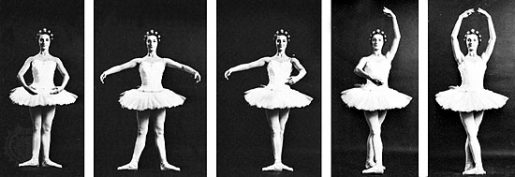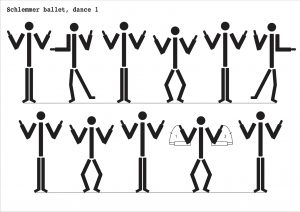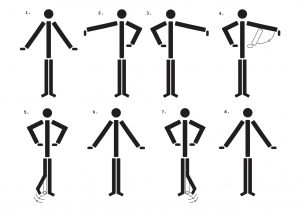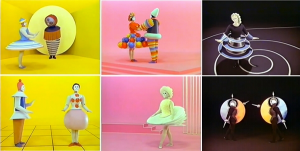The choreography, the costumes, the music and the decor that Schlemmer uses in his Triadisches Ballett were in my eyes the complete opposite of the classical ballet performances, for example The Swan Lake.
After further research, I actually came to the conclusion that it is difficult to compare, since his approach has had nothing to do with the telling of a story. Schlemmer’s ballet is based on three basic forms: square, circle and triangle and the various postures of the human body: standing, sitting, lying. These combined add up to an infinite number of variations and possibilities of interaction of the human body with space. In this approach, the choreography, the costumes, the music and the decor are all the same. The ballet is the result of the relationship and interaction of these four elements.
Even though Schlemmer’s choreography of the ballet was only a style element, equal to the costumes, the music and the decor, I consider it as the most crucial aspect of the ballet. Therefore, I asked myself: Can it be elevated to classical ballet if you omit the music, the costumes and the environment, and thus only focus on dance technique and choreography?
Ballet technique is the basic principle of exercise and form used in ballet. Within classical ballet there are some elements that distinguish it from other dance forms, such as the five basic positions, the turnout, balloon and the ‘pointe’ technique. The turnout is a rotation of the leg at the hips, causing the feet and knees to turn outwards, away from the front of the body. This rotation ensures a greater elongation of the leg, especially when tilting up and back. Balloon is an aesthetic in ballet and other dance genres, which makes it seem as if a dancer is effortlessly floating in the air, floating in the air and landing softly. The pointe technique is the part of the ballet technique that concerns pointe work, where a ballet dancer supports all body weight on the tops of fully extended feet and wears pointe shoes.
ballet pink
To answer my research question, I gave myself the task to learn ballet, to learn two dances. I did this to see if –when I do the dances without the costumes and surroundings in which the dance originally took place– it is rather seen as a classical ballet.
The start of this journey was a big failure, I started to reenact parts of the Triadisches Ballett. Almost immediately afterwards it dawned that it would be a lot harder than I had expected. A friend of my mom, who practices classical ballet, suggested that I sketch out every movement and position.
The first dance, yellow part, was way more easy to sketch out that the other one, the pink part had a lot of movement and positions switches really quickly, so I tried to make it as visible as possible.
While learning the Triadisches Ballett, I started researching classical ballet, so I also started to learn the five positions of classical ballet. I wanted to see if I could apply these five positions when learning the Triadisches Ballett.
Learning the movements and positions of my body progressed more and more, until the moment that I started to dance along with the original. I was very slow and took quite a long time to keep up with the rhythm. With the yellow part that went well quickly, even though my leg and arm coordination is not too good. The pink part lasted much longer, the combination of positions very quickly after each other and the twist with the leg going back and forth has been a long struggle and that includes most of the exercise.
While learning both the Triadisches Ballet, the classical positions and continuing to watch the ballet, I reached a conclusion. I have noticed that Schlemmer’s ballet has certainly included some positions of the classical ballet in his dance, not so much in the two that I have learned. In the very first dance section of yellow and pink, the woman dances with the pointe technique and combines it with the arm positions of all positions of classical ballet.
I have also noticed that throughout the Triadisches Ballet use is made of the ‘turnout’, not the feet entirely from the side, a milder version of the classic turnout. The ballet takes elements of classical ballet and applies these, but in addition to that Schlemmer does create many more elements in this dance that do deviate from the classical. For example, there are the more angular movements and the way of walking or running, which I would not call classical. They are a good reflection of the Bauhaus in ballet. The ballet takes classic elements and applies them, yet there are more non-classical movements and positions than classical, hence my conclusion.







